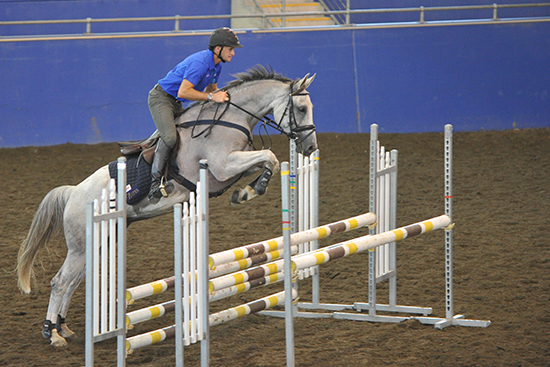 Words: Chris Hector and photos: Roz Neave
Words: Chris Hector and photos: Roz Neave
George Morris works with a mixed of showjumping and eventing riders: Hilary Scott and Oaks Miss Scarlet, Danielle Butcher and Twins Zenith, Stuart Tinney was riding Kinnordy Genuine, Emma Smith on Ego Casablanca, Ian Hamilton and Corriegador while Emma Scott is riding Jenbern Monyana.
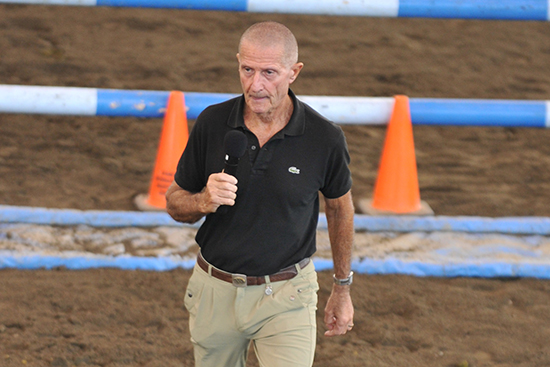
George always focusses on the issue of contact:
“Feel the hindleg in your hand, a steady hand. Today we have this fashion for hand riding, don’t copy fashion, what is important is correctness. You must have elasticity from your shoulder to the horse’s mouth, a straight line, a steady connection and elasticity of hand.”
Elastic but firm;
“The first problem is that riders drop their hand, they surrender their hand and the horse wins the battle of contact.”
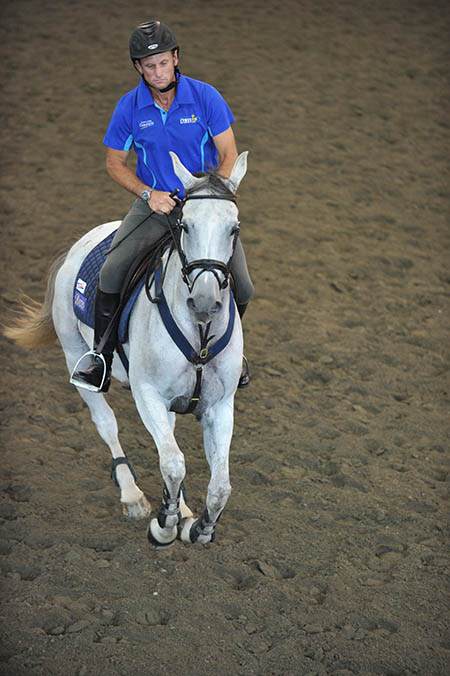
The next battle seemed to be the battle of the flying change – Stuart Tinney was having real problems with Genuine in the exercise which involved a change of lead within the circle – the mare would either canter disunited or drop into a trot. This time George had a new correction, one he tells us he learnt from the late Jack le Goff:
“When she crossfires, push her over with your inside leg until she changes and watch the she doesn’t trot, keep pushing her out with the inside leg. This is a different approach from the outside leg correction, but what’s most important that she doesn’t get into the habit of falling into the trot.”
Not surprisingly, Stuart wins the battle. The next little skirmish is with Emma Scott’s Monyana. Another of George’s pet hates is horses that kick up behind in the change: “If he goes up like that, push and raise your hands. If he goes up, get his poll up. Don’t put your outside leg too far back, that’s like a fly asking them to kick up.”
Once again a horse offends by kicking up behind in a change: “Leg the sucker, clamp those legs, rip with the legs, that is a really huge resistance.”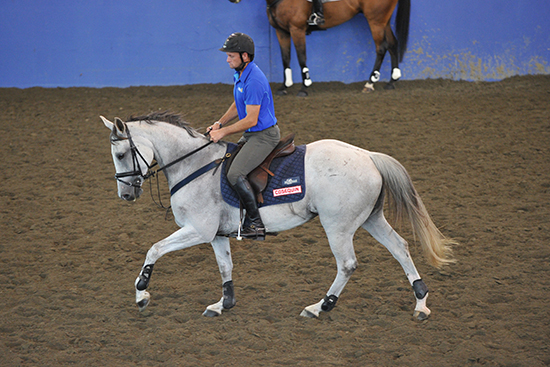
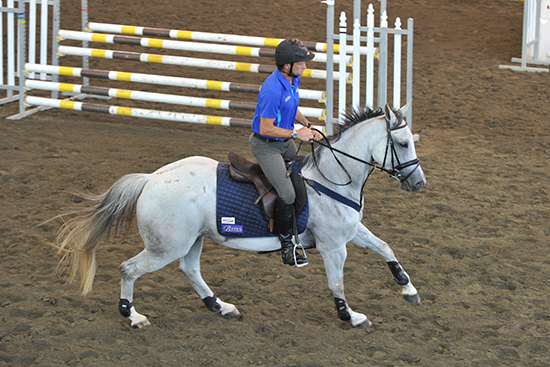
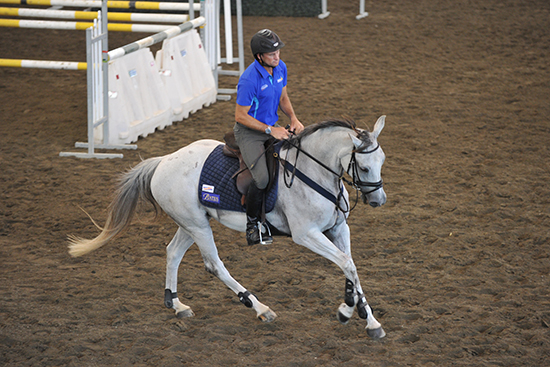
Stuart Tinney works on changes with Kinnordy Genuine
“The psychiatrist of the horse is dressage. It is dressage that keeps him well physically and emotionally. Once a week, jumping riders should incorporate dressage into their riding – the eventers have to do it, and you can see the difference in their dressage.”
One of the horses blows out and George is delighted: “When the horse makes that brrr sound, that is the greatest sound because it tells you the horse is relaxed and accepting the aids.”
But that’s enough, let’s get galloping, another of those figure eights, over the vertical, tight turn right, over the oxer, tight turn left and back on the vertical.
“This exercise is one of my favorites, it gets a very loose and forward rider. Just let the horse go forward and wait for the distance, wait to the base of the fence. ‘Patience’ – I don’t like that word, it is a bit too sweet, it reminds me of all those ‘baby sitter’ instructors who are so sweet to the little darlings, they are always talking about ‘patience’. But it is true that when the training is slow, the progress is quick, when the teaching is quick, the progress is slow.”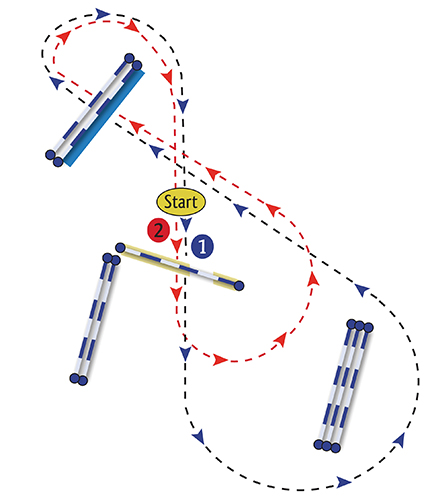
Exercise One: Blue Line; Exercise Two: Red Line
“What is important with these fences is that the horse doesn’t cut in, that it goes back to the track. The great Piero d’Inzeo told me, let the horse go forward, then wait for the horse.”
“Give, give, give, be interested in giving. Of course you have to make a half halt with both your hands, but you have to get off the half halt. The half halt puts the horse on his hocks. The half halt for jumping is not as complex as for dressage, just take and give. Take for a maximum four counts, then get off. On the fifth count you are hanging on the mouth, that’s too long.”
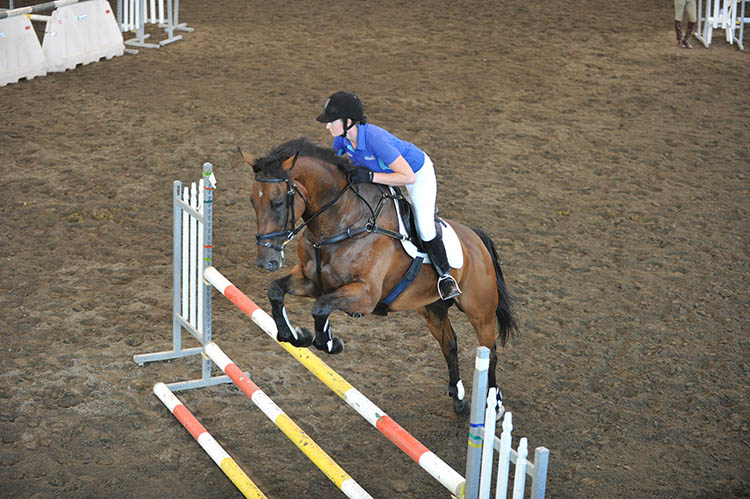
“It’s great for horses and riders not to always have related jumps, not always obsessed with the measuring tape. Fast galloping work is important not for bending but for rotating the shoulder and fixing the haunch. Watch a horse in the paddock when he is travelling very fast, he might even be a little bent to the outside. At a certain speed, there is not much bending.”
And to the onlookers…
“It’s like the Coliseum, some of you are not here to see the equitation, but to watch the blood bath – as soon as I start to babysit, I retire.”
Now it was time to tighten the turns… over the vertical round the triple bar, over the Liverpool, tight turn back on to the vertical and this time go inside the triple bar to get to the Liverpool.
“You have absolutely no time to look at your horse – look ahead.”
But even when we are galloping there are certain niceties that must be observed:
“STOP! Is your stirrup twisted correctly? We must be meticulous.”
“The worst enemy of riding after rough, is stiff.”
read on below
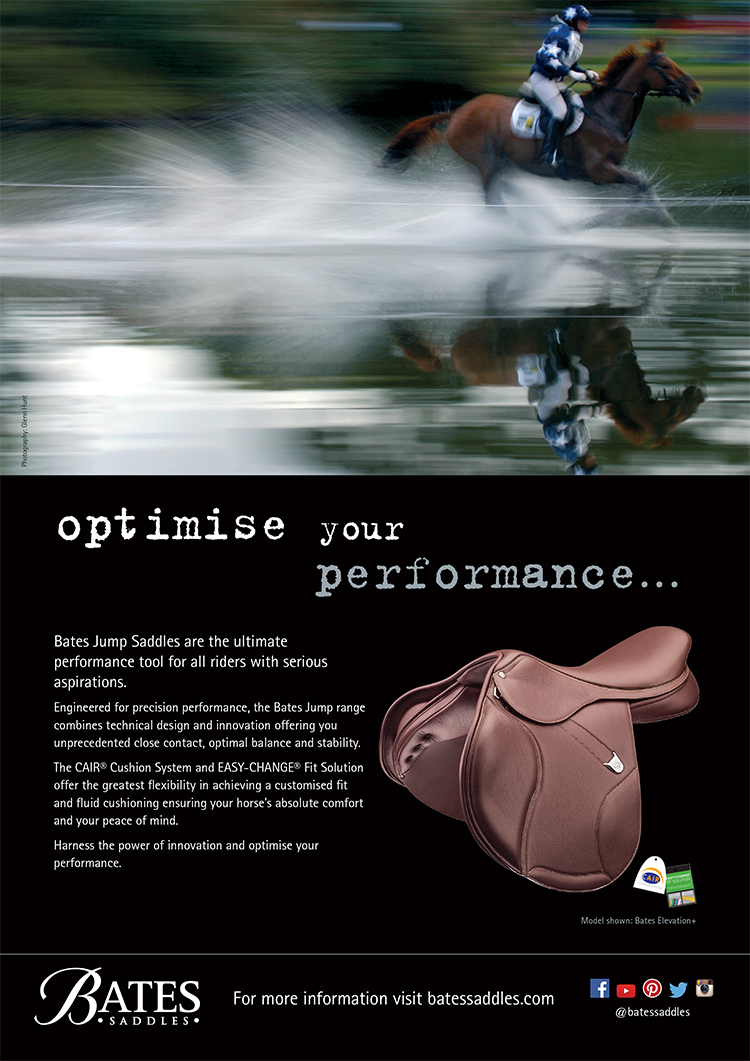
George points out that this exercise is particularly good for Stuart’s mare:
“The figure eight helps teach her the outside leg, and this is good for her because she’s a little bit of a hard-boiled horse. With a horse like this, you have to be super progressive, super gradual, so she starts to accept the outside leg. This type of horse forces you to learn tact.”
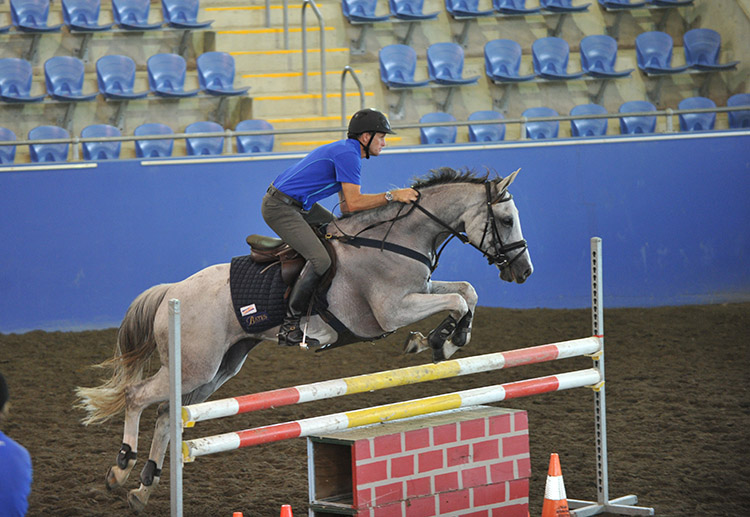
“Let her go forward so you can shorten, shorten. If you don’t let the horse open up in the turn it is impossible to compress the stride as you approach the fence. Let go, and at the fence, you package the horse.”
George was concentrating on Emma’s big Carthago grandson: “Package him as close to the fence as possible. Drop him, drop him, package, package, drop him…. Like everything in life, we have to get the feel, first by understanding, then by practicing. At the end of the day it is feel. You have to get there through the mechanical instruction process, but then it is feel. When you are at a horse show, watch, watch, watch. Look at Phillip le Jeune at Kentucky, he was the absolute winner, he rode every horse better than the others, he warmed up with tact, tact, tact. He out horsemaned the others, he was very sympathetic to the horses.”
Another exercise is waiting
Over the vertical, tight turn to the oxer, over the wall, six to the Liverpool, and five back on the vertical. Stuart’s mare stops on the final vertical. “Use your spur, the whip is too strong.”
She stops again.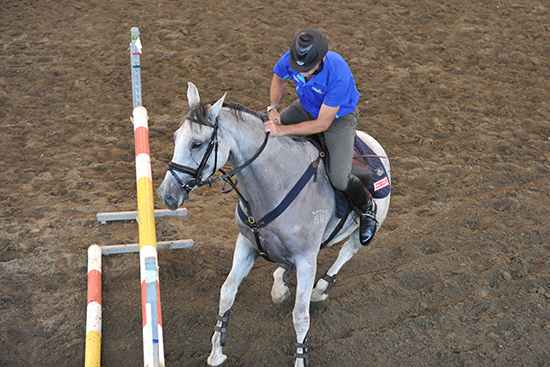
“Just jump the vertical.”
Stops again… then jumps it.
“Repeat the whole thing. She’s green and with these false ground lines, she is looking for a little out.”
This time the mare goes round the track in fine style.
“You have to ask the horse to get clever with the construction of the fences, that’s why there is a false ground line on the final vertical with the rail on the far side. Horses don’t like false ground lines, but they have to work for a living. They have to become agile and intelligent.”
“Done correctly, repetition is the teacher, but you have to ride very well to let the horse get the message of the question and the answer.”
“Now we are going to approach the vertical at a positive gallop, 350 to 370. The top riders have perfected fast gallops to deep spots – you need speed and round jumping. When the fences are delicate, you need pace to the base.”
Next exercise was the little vertical, tight left to the triple bar, over the oxer, vertical, then the wall and a tight turn left to finish.
And when Emma gets her big camel to the spot, George is delighted:
“That’s perfect, now he starts working for a living. No one arrives at every fence perfect WORK IT OUT. The fence has to hold the horse, the fence has to round the horse, not you. Let the fence help you do the work. With any habit, first it is difficult, then it is easy, finally, it is beautiful.”
And some of the riders at least are getting good habits, three of them without being asked lengthen their leathers and take their feet out of the stirrups.
“That’s good, whenever possible I take my feet out of the stirrup. Once a week I like to ride for 45 minutes without stirrups.”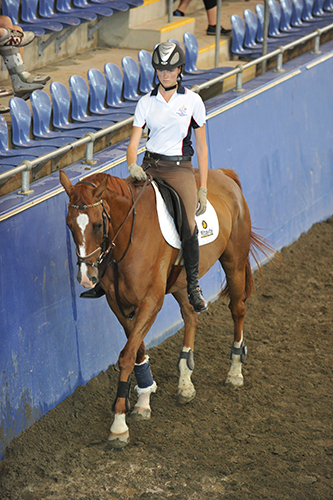
And just in case we hadn’t got the message, for the third group, off went their stirrups, reins bridged and held in the outside hand, and it was on – sitting trot, rising trot, canter with their feet in front of the saddle, serpentines, shoulder in, half turns and leg yields, walk, counter canter, walk, counter canter through the corners and then to make things interesting, counter canter across the diagonal with a flying change. It was again a little scary. This was a group of quite advanced riders, finding it difficult to come to grips with what George calls a ‘basic understanding of riding’.
We’ve come a long way, but oh dear, there is a long way to go yet… Let’s hope that George keeps coming back for many years to remind us that riding is simple but demanding…
This article first appeared in the June 2011 issue of THM.


